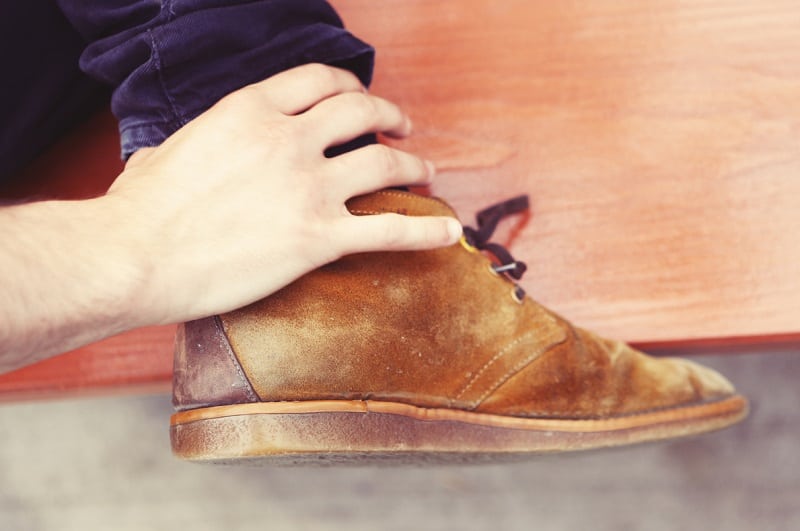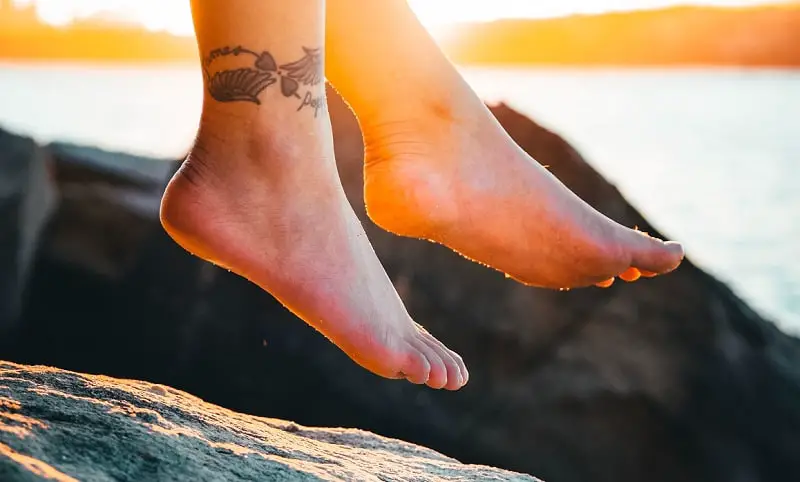Have you got a new pair of shoes that you were excited to wear until they started to cut into the back of your ankle or heel? Nobody likes wearing-in a new pair of shoes, and rarely do they come perfectly fit to your foot.
If your shoes are cutting the back of your ankle, it is most likely due to one of the most common core causes:
- New pair of shoes that need to be broken in
- Shoes are fitting too tight
- Shoes are fitting too lose
- Shoes that need service from a professional cobbler
Let’s take a deeper dive into each cause to learn what to do to get your shoes worn in and fitting comfortably.
The Pains of a New Shoe
A new pair of shoes can cause pain in your foot. Your feet are your connection to the ground, and you want to keep them healthy and pain-free. Do not take foot pain lightly; always make sure your shoes fit well and offer the best support possible.
Some potential foot injuries from rubbing shoes include:
- Friction blisters are the most common injury from a rubbing shoe
- Open wounds usually occur from the shoe fit being too tight and rubbing on the ankle
- Achilles Tendonitis this happens from a more constant rubbing or cutting of the ankle
- Achilles Tendonosis again more common from repeated rubbing or cutting
- Bursitis: our bodies have fluid-filled sacs called bursae that help cushion our bones and tendons, an ill-fitting shoe can cause them to become inflamed
If you have any of these conditions, it is best to stop wearing the shoes until you have fixed the problem. Otherwise, you risk prolonging the injury or even making it worse.
If you have blisters on your feet, use heel cushions/bandages (Amazon) to protect the area, allowing it to heal.
While your feet are healing, try some of these methods to get a more comfortable fit.
Getting The Right Fit

In general, your shoes cutting into the back of your ankle are an indication that they do not quite fit properly. If your footwear is cutting into your ankle, it is likely because they are too tight.
Shoes That are Too Tight
You can try stretching them out using one or more of these methods:
- Anti-friction sticks: these work like an antiperspirant. You roll it over the area of your foot that comes into contact with the part of your shoe that rubs. These anti-friction sticks contain a balm that creates an invisible layer of protection between your foot and shoe. This layer allows the footwear to move freely, reducing the friction that leads to cut or blister formation.
- Leather conditioner: This really only works for leather or sued. Apply it to the offending area of the shoe to make the material softer and more supple. Look for mink oil or beeswax. You can check out the leather conditioner we recommend here.
- Shoe Stretch Spray: Spray the area of the shoe you want to stretch and then walk around in them while wearing a thick pair of socks, or many-layered socks until the area has dried. Repeat as needed to get the desired fit.
- Shoe tree: These are usually used for preserving shoe shape. If the shoe tree (Amazon) is slightly bigger than your shoe, it can be used to stretch the shoe. Simply put them in whenever you are not wearing the shoe.
- Shoe stretcher: Similar to a shoe tree but they have a knob to turn, which will increase the size of the device. Place the shoe stretcher (Amazon) in your shoe and turn the knob until it is snug in the shoe. Leave for eight hours and check the fit. Repeat if needed.
- Hairdryer: The heat can make the shoe material more pliable, allowing you to stretch it out.
- Put on a thick pair of socks or layer up thinner pairs
- Carefully heat the back of the shoe on medium heat (be sure not to melt or burn the material)
- Walk around until it cools, repeat as needed
These methods are most effective on natural materials such as leather, suede, and some fabrics. They are not effective for plastic and other synthetic materials.
If you are buying shoes made from a synthetic material, consider buying slightly too big rather than too small and use one of the following methods to fill in the little bit of extra space.
Shoes That are Too Loose
If you are getting blisters from your shoes, they are likely too loose. Try one of these methods for shoes that are just a bit too big:
- Insoles: Shoes that are too loose will slide along your heel/ankle and rub, causing blisters. Adding an insole (Amazon) will take up the extra room and give your foot better support and cushioning. They will also raise your foot up, leaving less area for contact between the shoe and our ankle.
- Most insoles need to be trimmed to the correct size. They are usually marked on the insole, but you should insert the sole, note where it reaches the tip of the shoe, and trim it to length.
- Moleskin: This strong yet thin cotton fabric is durable and comes with an adhesive on one side that you can either stick to your foot or on the inside of the shoes. Make sure the surface that you adhere to the moleskin to is clean and dry. The moleskin provides padding to prevent friction blisters.
- Place a length of moleskin inside the shoe over the offending area.
- Trace the area on the moleskin (make sure that the moleskin is slightly bigger to provide maximum protection).
- Trim the moleskin and peel off the backing to reveal the adhesive.
- Place moleskin over the offending area (make sure the area is clean and dry so the moleskin can effectively adhere).
- Heel cushions: These are padding, usually gel, that provide extra cushion and support but can also make for a tighter fitting shoe. Get ones that provide padding below and around the back and sides of the heel/ankle.
- Antiperspirant: Sometimes, blisters are due to chafing. If this is the case, reducing moisture will reduce chafing and thus blistering. Apply some before you don your new shoes.
- Layer your socks: this will take up more space inside the shoe, offer more cushion, but also the layers of socks will slide against each other rather than your ankle and shoe rubbing.
- Duct tape: The duct tape goes on your heels/ankle, not on the shoes. This method works best for heavy-duty applications like work boots or hiking shoes. If the other padding wears out too quickly, this can be an effective method.
It might be a bit of experimentation to find the solution that works best for you and the pair of shoes in question. Try different methods until you find the one that fits best.
If you want additional info, you can also check out the video below for a few more tips for getting your feet happy and healthy again.
Take Your Shoes to a Cobbler
If these methods seem like too much work or you do not want to risk damaging an expensive pair of shoes, take them to a professional.
Cobblers make their living working with shoes. They have many techniques and specialized tools at their disposal to get your footwear fitting just right. In general, it is best to go to a cobbler for shoes that are too small, and you will get the best results if the shoes are made from a natural material. Modern synthetic materials do not stretch like their natural counterparts.
Putting Your Best Foot Forward

When you buy a new pair of shoes, consider the material they are made from before making your size selection. Unless you can get the perfect fit, you will likely need to use one of the above methods to personalize the shoe to your feet.
If the shoes were built using a natural material, they can be stretched out. If they are made from synthetic materials like pleather, buy them slightly larger in size rather than smaller and use extra cushioning to fill up the remaining room.
Remember, your feet are your base and need the best of care to keep things well supported and moving comfortably. Now that you’ve taken your new shoes to their maximum comfortability get out there and strut your stuff!
